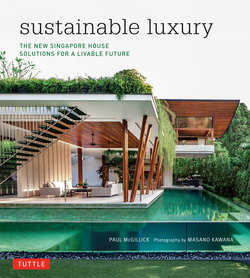Читать книгу Sustainable Luxury - Paul McGillick Ph.D - Страница 9
На сайте Литреса книга снята с продажи.
ОглавлениеNEIL ROAD SHOPHOUSE
EXPERIENCE DESIGN STUDIO, ONG&ONG
‘The brief was for a place she was truly comfortable with. The question was: How could we create a place where she could feel she had lived forever?’—MARK WEE, ARCHITECT
Looking from the entry through the original house, past the two courtyards to the new addition.
The street façade has been completely restored, including the original brilliant blue colouring.
This is a house that addresses sustainability from several perspectives: personal, cultural and environmental. It is one of a strip of conservation shop-houses which, in terms of their heritage value, are in the top category because of the historical value of their façade ornamentation. Shophouses in Singapore display a variety of influences (British, Dutch, etc.). This one is undeniably Chinese, dating possibly from the 1860s, and was originally the home and business premises of Straits Chinese (Peranakan) merchants. In fact, another house in this strip (the Baba House at No. 157) was donated to the National University of Singapore who have restored it and now manage it as a museum open to the public.
It has, of course, become highly fashionable among both locals and expatriates in Singapore to try and get hold of shophouses and refurbish them internally (the exterior can only be restored) as contemporary homes. What makes them so attractive? Part of the appeal is that they offer urban living but with a high degree of privacy. At the same time, they offer character along with the opportunity to modernize them without compromising that character. They also cater to that very human need to feel part of some kind of cultural continuity. Finally, because of their organization around an internal lightwell, they provide a natural source of light, fresh air and cooling.
This house had been in the family for over twenty years and the daughter felt a very special attachment to it. When she returned to Singapore to live, she wanted to use it as a home for herself and her family. ‘I told Mark,’ she says, ‘that I didn’t want a house, I wanted a home.’ The restoration and additions that followed were therefore very much to do with home-making and place-making. The project for Mark Wee and his client was to have the house tell its story through sensitive restoration, including interior features whose restoration was not mandatory, while including all the amenities of a contemporary home.
Long section.
Part of the strategy was to reveal the historical layering and, at the same time, add to it by using recycled elements as loose furniture, for example, the use of original stair treads as book shelves, and by new structural work which, in its form and materials, complemented the existing house.
Beyond the original courtyard is a traditional dining room and a new contemporary kitchen.
Looking from the sitting area near the entry, the new seems to evolve seamlessly out of the old.
Typical of many recycling elements throughout the house are the display shelves made from former stair treads.
This process begins at the street front of the house where, apart from ongoing restoration of the façade ornamentation, the side wall has been stripped back to reveal the old patina. Inside, the traditional screen at the entry to the shophouse has been retained, and in keeping with tradition two mirrors stand guard on either side of the door to trap evil spirits. The plaster has been stripped back to expose the original wire-cut bricks, and the frescoes and remarkable relief sculptures that form part of the original water feature in the lightwell/courtyard have been restored. Upstairs, the original operable timber shutter windows have been retained and restored, as has the original teak flooring.
This is all part of an agenda for cultural sustainability. Key to this is the idea of giving the house a voice and allowing it to tell its story. This story is historical, but it is also a living story that is embodied in the way the house itself is a journey. Wee and his client have now embellished that story with additions that not only add to the functionality of the house but also serve an environmental agenda. Having questioned his client about her childhood memories and about where she spends most of her time, the idea emerged of creating a second enclosed courtyard using the open courtyard land at the rear, which would connect seamlessly with a new kitchen/dining space. The kitchen is now the hub of the house and forms the base of an addition that includes a home office, the master bedroom, a roof garden and an attic above, all linked by a supplementary staircase (there is a new steel stairway linking levels in the original front part of the house).
A new steel stairway connects the ground and upper floors of the original house.
The roof garden terrace.
The new kitchen looking back across the new second courtyard.
The new master bathroom, partly open to the outside.
The new kitchen with the home office above.
Plans.
Traditional elements harmonize with the contemporary new wing.
The new courtyard draws in further light and air, minimizing the need for air-conditioning. It also sets up layers of transparency through the house by adding to a network of transition spaces. In fact, at nearly every point in the house it is possible to see the rest of the house, creating constant visual stimulation and a sense of how the house comes together as a family of spaces.
The entertainment room upstairs in the original house has a brick feature wall and restored fenestration.
The master bedroom upstairs in the addition combines the contemporary with antique and recycled elements.
